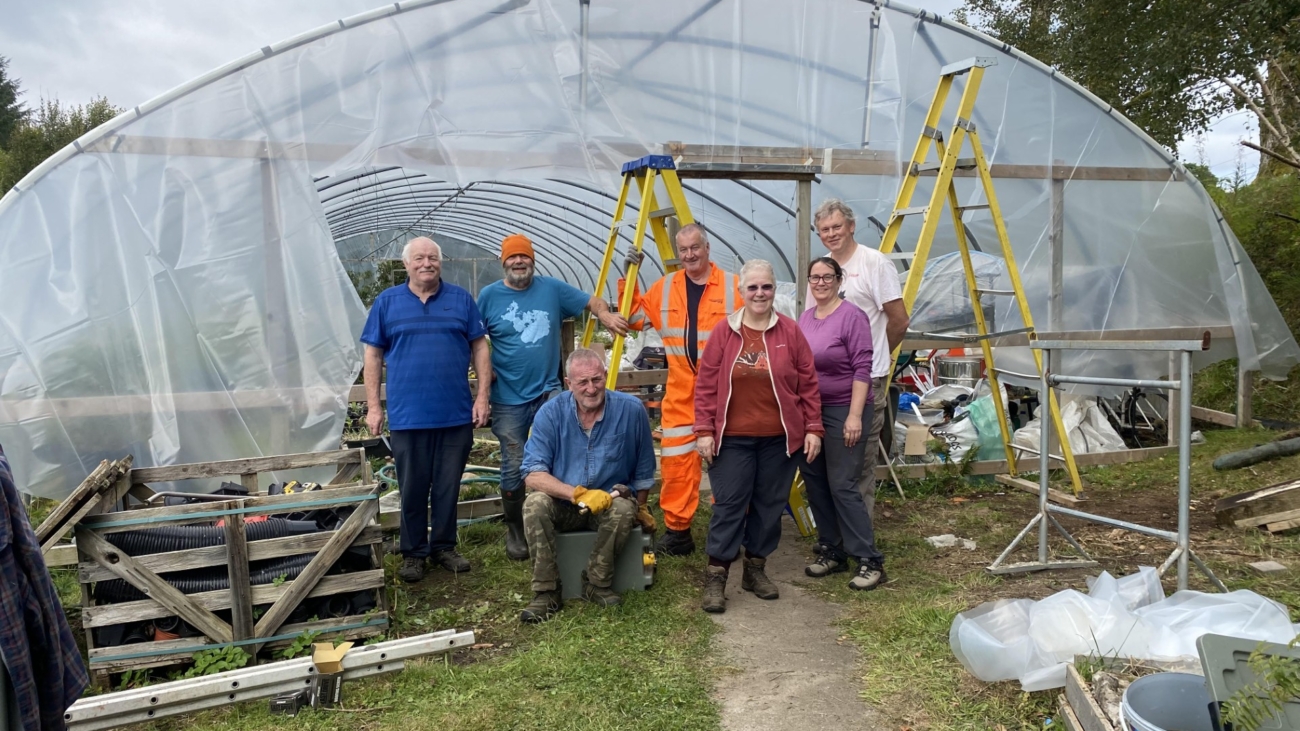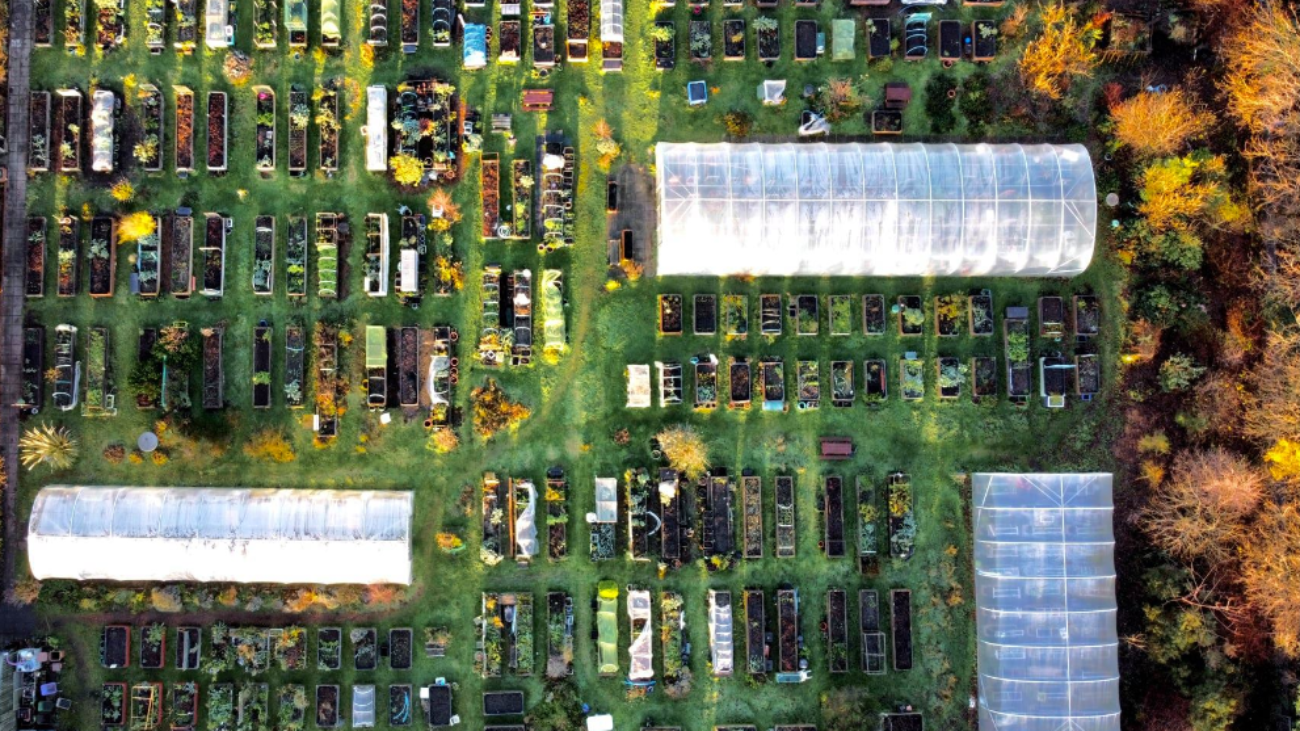Nancy Maqueen from Fairlie Organic Growers makes the case for tunnel growing.
Organic Growers of Fairlie (Ayrshire) started growing outdoor veg in raised beds on a coastal brownfield site in 2008 with less than 20 members. Membership quickly increased when we got our first makeshift polytunnel. There has always been a waiting list for our three large polytunnels, which house 134 raised beds, each 6ft x 2ft x 2 ft.
Benefits: A polytunnel of any size is an excellent complement and extension to outdoor growing. With careful planning and timely planting, you can harvest tomatoes, cucumbers, sweetcorn and peppers in summer, aubergines, chillies, even sweet potatoes in autumn, winter greens and spring onions through winter, crispy lettuce in March and early potatoes in April/May, before the growing cycle both outdoors and indoors begins again.
One raised bed grows an average of 4 tomato plants with smaller crops such as basil, herbs, or marigolds (for pest deterrent). The bed user harvests an average of 4 to 6 kilos of tomatoes per plant or around 15 kilos per bed. Some choose to grow cucumbers and beans as well.
The vegetables and fruit found in our tunnel include grapes, carrots, garlic, lettuce and oriental greens, perpetual spinach, chard, beetroot, spring onions, bulb fennel, and landcress.
Members are allocated one polytunnel bed per household where available. Membership usually includes one or more outside beds, although some choose only to have a polytunnel bed.
Some of our growers wait for spring, some grow through the winter, and others benefit from the extended growing season well into autumn.
The tunnel is a great place to grow unusual vegetables and fruit. We have a member from the Philippines who grows fantastic 2ft long beans and a strange-looking cucumber-like fruit. Romanian members also grow a long yellow Romanian bean, and an Indian member grows special beans along with a prolific grapevine. It is a great place to experiment.
The tunnel has a good social aspect with a shared interest in growing. Seeds are shared, and gardening experiences and new friendships are made. It is a place to shelter from the rain and to meet in the winter when there is always work in the tunnels to do and plan for spring.
It is a pleasure to have young children and schools visit the polytunnels and learn how their food is grown. High school-age and older students have worked in the tunnels and have achieved many certificates and awards, such as The Grow and Learn Award.
Practicalities: Our beds are lined with recycled black polythene to help retain moisture and extend the life reducing the contact between the wood and soil. We plan and save to reskin our tunnels circa every ten years. We have set aside a reserve for funding and repair in our accounts. Skinning tunnels need to be undertaken in warm weather when the plastic has give in it. We’d recommend specialist contractors for large tunnels.
Our tunnels all have a clear light-diffusing Visqueen anti-mist polythene (lumisol). The ground is covered with black weed-suppressing matting with stones on top; any weeds coming through need to be dealt with quickly as they can grow fast in tunnels.
We have raised beds in two rows on either side of the tunnel. The beds have attached frames and a rack on top for bringing seeds in trays. The rack also provides support for plants.
There is a 2 ft space for wheelbarrows between each bed and a 3ft path in the middle of the tunnel. There are double doors on each end of the tunnel, and we also have an overhead watering (mist) system as air temperatures can be up to 40C on very hot days.
A high bed at the front near the door and space for another enables wheelchair access. The tunnel is beside a concrete path for disabled/wheelchair access.
In summer, three hundred litres of water are used daily in the tunnel or about 10 litres per raised bed. We harvest rainwater from our shed, and there are three 200L barrels in the tunnel for members to hand water their beds. The stored water and thermal mass of the raised beds absorb heat during the day and gradually cools at night, keeping the tunnel warmer for longer.
We have 2 Hot Bins for compost making and providing nutrient-liquid feed. This is in addition to outdoor barrels of comfrey/nettle mix feed.
Each raised bed has a mixture of local topsoil, peat free and our own organic compost and organic alpaca dung (which we can access). It also contains kelp and some rock dust. We have had local deliveries of compost when required. Good soil maintenance is essential in raised beds to keep the soil healthy and productive all year round.
A tunnel should be opened in the mornings in the summer and closed if possible, an hour before sunset to maintain the day’s warmth. Ventilation prevents moulds and fungi and lets plants cool themselves.
In winter, it can be opened in the morning to let cold/damp air out. Drafts in winter can be minimised by a cloth/draft excluder placed at the bottom of one door of a two-door tunnel.
Challenges: All types of weeds grow faster and bigger in polytunnels! Regular weeding in and around beds is essential.
Algae and slime accumulate on the polytunnel skin when plants are too close. This must be removed to let light in by hand cleaning with a sponge or spraying with a hose.
If beds are not watered and kept moist, slaters will thrive, eating the roots of young cucumbers and other plants. If cucumbers are planted when larger, it is less of a problem. We use a chemical-free powder called Desi Dust to deter slaters and ants.
We have had red spider mites in the tunnel, and plants had to be removed, but seldom are whitefly or greenfly present.
There has been a lot of mildew on courgettes, and leaves had to be removed, but ultimately, the whole plant will need removal. Courgette leaves can encroach into shared spaces if left as they grow larger in tunnels.
Our garden members tend to be older due to the easier option of growing in raised beds. Sometimes, beds are not tended to due to health issues, and volunteers kindly help. As 134 members use three polytunnels, there is a big difference in bed care, commitment and expertise. Tomatoes are not an easy crop to grow, and with so many choosing them, there are often broken branches due to improper pruning and support. There can be splitting tomatoes and other problems due to inconsistent watering—fruit unpicked when ready falls to the ground. Casual neglect in the tunnel is serious without the effects of weather, such as rainfall and the natural replenishing of soil by worms. We have our best results in the tunnel environment without the damage pigeons cause in the garden. Birds in the tunnels eat a few strawberries, and mice will eat peas if they are unprotected.









